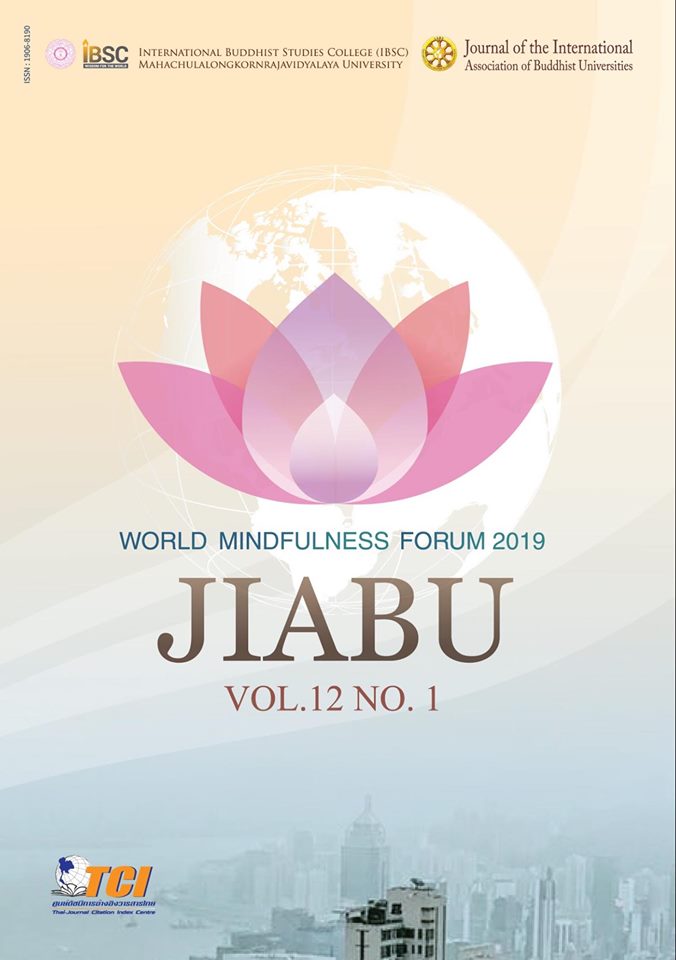Sectarian Thoughts Alternations among Different Versions of the Prajñāpāramitāhṛdaya, the Heart Sūtra, until the Time of the Yogācāra School
Main Article Content
Abstract
By the variants found in the textual expression among different versions of the
Pra jñāpāramitāhṛdaya, the Heart Sūtra, this article tried to ask and answer the questions
which nobody has asked before in the academic field: Why the extant Sanskrit texts are
treated as the original form? If they are something that has been altered, in what sense
that they can be used as the base of comparison? Simply speaking, how do we know that
they are the most primitive appearance? By some basic arguments and the study of the two
crucial differences among different versions of the Sūtra, the researcher discovered that the
scripture had been undergoing a chain of alternations due to sectarian thoughts differences
between schools. The earlier version consists of thoughts of the Mādhyamika school was
later altered into a form which is correlated to the doctrinal ideas of the Yogā cāra school.
These ideas involved the concept of seeds, Ālayavijñāna, its related aspects as well as the
Three-natures. All of these ideas are the core doctrines of the Yogācārian teachings which
gave them no choice but to delete the Mādhyamikan sole acceptable sentences in the original
Sūtra. The extant Sanskrit text also shows such alternations which means it is without a doubt
belong to the product of the later stage of Buddhism development.
Article Details
Views and opinions expressed in the articles published by The Journal of the International Association of Buddhist Universities (JIABU), are of responsibility by such authors but not the editors and do not necessarily reflect those of the editors.
References
Vol. 1. London: The Pali Text Society.
Fumimasa, F. (福井文雅) (1987). 般若心経の歴史的研究 (Hannya shingyō no rekishiteki
kenkyū). Tokyo: 春秋社 (Shunjūsha).
Hidas, G. (2015). Dhāraṇī Sūtras. Brill’s Encyclopedia of Buddhism. Vol. I Literature and
Languages. (2015): 129-137.
Horner, I.B. (tr.) (1997). The Book of the Discipline (Vinaya-Piṭaka). Vol. V (Cullavagga).
Oxford: The Pali Text Society.
Nattier, J. (1992). The Heart Sūtra: a Chinese apocryphal text? Journal of the International
Association of Buddhist Studies. Vol. 15 (2). (1992): 153-223.
Tanahashi, K. (棚橋一晃) (2014). The Heart Sutra: A Comprehensive Guide to the Classic
of Mahayana Buddhism. Boston: Shambhala Publications.
Takakusu, J. and Kaigyoku W. (ed.). (1924-1935). Taishō Shinshū Daizōkyō《大正新修大
藏經》 . Tokyo: Daizo Shuppansha. With following scriptures (sorted by names of
authors or translators):
. Asaṅga (無著). Xuan Zang (玄奘) (tr.). Mahāyānasamgrahaśāstra 《攝大乘論
本》 . Vol. 31. T1594.
. Asaṅga (無著). Xuan Zang (玄奘) (tr.). Prakaraṇāryavācāśāstra 《顯揚聖教論》 .
Vol. 31. T1602.
. Chosgrub (法成) (tr.). Bore boluomiduo xinjing《般若波羅蜜多心經》 . Vol. 8.
T0255.
. Dānapāla (施護) (tr.). Foshuo shengfumu bore boluomiduo jing《佛說聖佛母般
若波羅蜜多經》 . Vol. 8. T0257.
. Dao Xuan (道宣). Xu gaoseng zhuan《續高僧傳》 . Vol. 50. T2060.
. Dharmacandra (法月) (tr.). Pubian zhicang bore boluomiduo xinjing《普遍智藏
般若波羅蜜多心經》 . Vol. 8. T0252.
. Kumārajīva (鳩摩羅什) (tr.). Mo he bore boluomi daming zhou jing《摩訶般若
波羅蜜大明咒經》 .Vol. 8. T0250.
. Kumārajīva (鳩摩羅什) (tr.). Pañcaviṃśatisāhasrikāprajñāpāramitāsūtra《摩訶
般若波羅蜜經》 . Vol. 8. T0223.
)
. Maitreya (彌勒). Xuan Zang (玄奘) (tr.). Yogācārabhūmiśāstra《瑜伽師地論》 .
Vol. 30. T1579.
. Nāgārjuna (龍樹). Kumārajīva (鳩摩羅什) (tr.). Mahāprajñāpāramitāśāstra
《大智度論》 . Vol. 25. T1509.
. Prajñā (般若) (tr.). Bore boluomiduo xinjing《般若波羅蜜多心經》 . Vol. 8. T0253.
. Prajñācakra (智慧輪) (tr.). Bore boluomiduo xinjing《般若波羅蜜多心經》 . Vol.
8. T254.
. Shen Qing (神清). Hui Bao (慧寶). Bei shan lu《北山錄》 . Vol. 52. T2113.
. Sthiramati (安慧). Xuan Zang (tr.). Abhidharmasamuccayavyākhyā《大乘阿毘達
磨雜集論》 . Vol. 31. T1606.
. Xuan Zang (玄奘) (tr.). Bore boluomiduo xinjing《般若波羅蜜多心經》 . Taishō
Tripiṭaka《大正藏》 . Vol. 8. T0251.
. Xuan Zang (玄奘) (tr.). Mahāprajñāpāramitāsūtra.《大般若波羅蜜多經》 . Vol. 5
to 7. T0220.
. Zhi Pan (志磐). Fozu tong ji《佛祖統紀》 . Vol. 49. T2035.
. Zhi Sheng (智昇). Contents of the Buddha’s Teaching Collected in the Period of
Kai Yuan《開元釋教錄》 . Vol. 55. T2154.


